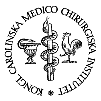Animation

An animation illustrating the discovery the 1997 Nobel Prize in Physiology or Medicine, shown during the press conference on October 6, 1997 at Karolinska Institutet, is presented here. The latter part of the presentation contains only images and text.
This is a 2.7 Mb Shockwave animation.
| To download the Shockwave player, click on the icon to the right. |
This animation gives a very simplified view of how prions cause fatal neurodegenerative diseases of the brain in man and animals.
1. The prion protein PrP is a normal constituent of many cell types in the body, notably nerve cells (neurons) in the brain. The name prion (pronounced pree-on) is derived from “proteinaceous infectious particle.” In its normal conformation, the prion protein (termed PrPc) is innocuous. Its function in the body is still unknown. However, PrPc can undergo a conformational change, adopting a harmful, disease-causing shape termed PrP-scrapie, or PrPSc. Scrapie is a transmissible spongiform encephalopathy of sheep identified in Iceland as early as the 18th century.
The conversion of the PrPc-form to the PrPSc-form occurs at an extremely low frequency. The process may be compared to the transformation of Robert Louis Stevenson’s novel character, Dr Jekyll, to Mr Hyde – the same entity but in two manifestations – a “kind”, innocuous one and a “vicious”, lethal one. PrPSc has unusual properties. It is stable to treatments at high temperatures (100°C), UV-light, and ionizing irradiation enzymes that normally destroy proteins and nucleic acids and some detergents. Such treatments would destroy all known viruses.
| next |
Nobel Prizes and laureates
Six prizes were awarded for achievements that have conferred the greatest benefit to humankind. The 12 laureates' work and discoveries range from proteins' structures and machine learning to fighting for a world free of nuclear weapons.
See them all presented here.
